Page 17 of 25
Downloaded from www.Manualslib.com manuals search engine Airflow The airflow selector directs air to the floor, panel or defrost vents, or a combination.RecirculationThe recirculation function prevents outside air and odors from entering the cabin. It may also be used in conjunction with AC to cool the cabin more quickly.Fan SpeedFan speed is the same for both zones. Fan speed can
be adjusted by first pressing the button and then adjusting the fan speed with either the driver or
passenger control knob.Automatic Climate Controlcont.
27
Temperature
Fan speed
Airflow directions
MMI
® Display
Your climate control adjustments such as Temperature, Fan speed and Airflow can be seen on your display for convenience.NOTE: Temperature display only shown with MMI® Navigation system. The ideal fan speed to heat or cool your interior will be displayed with a on the fan speed level.
28
AutomaticClimate Control
Page 18 of 25
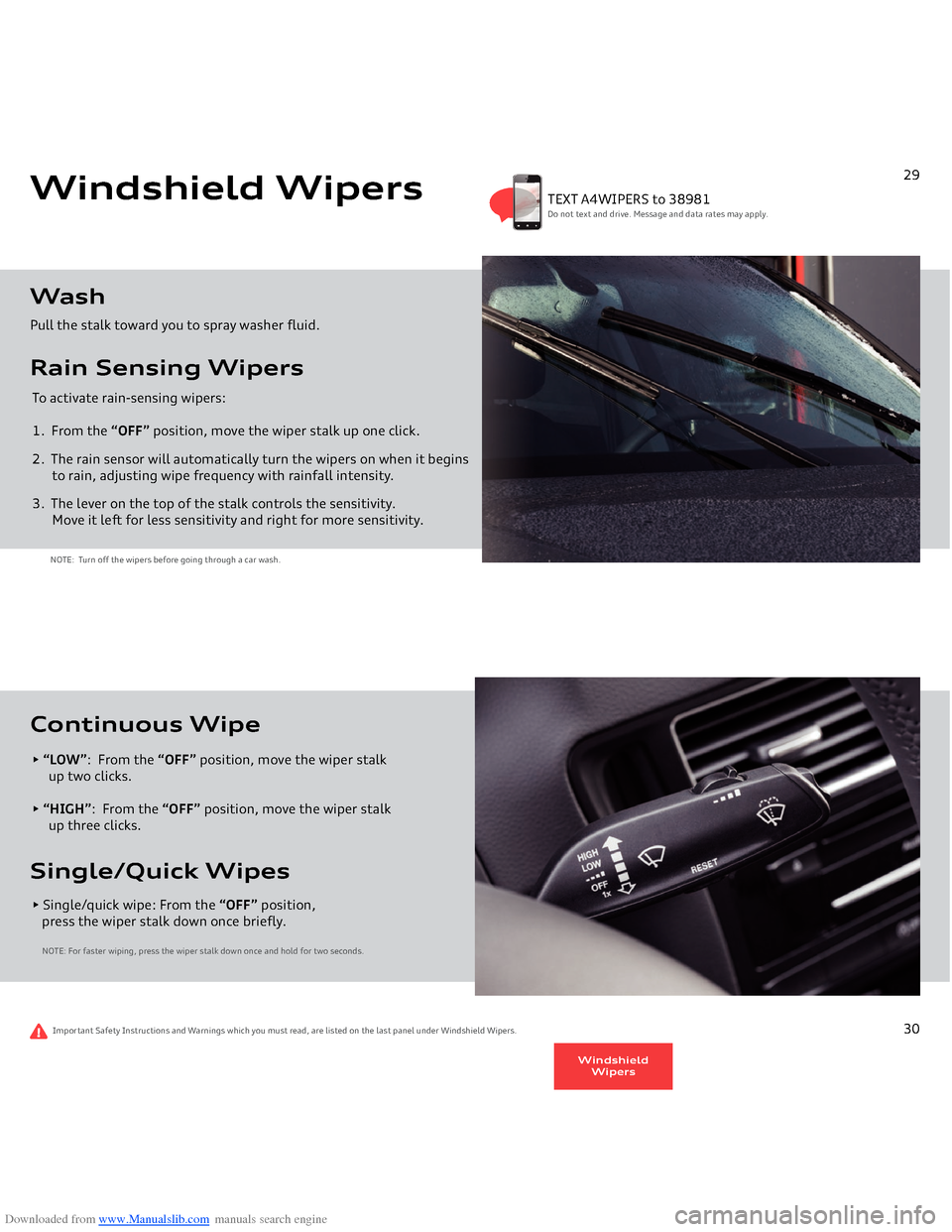
Downloaded from www.Manualslib.com manuals search engine Windshield WipersPull the stalk toward you to spray washer fluid.WashRain Sensing WipersTo activate rain-sensing wipers:1. From the
“OFF”
position, move the wiper stalk up one click.
2. The rain sensor will automatically turn the wipers on when it begins
to rain, adjusting wipe frequency with rainfall intensity.3. The lever on the top of the stalk controls the sensitivity. Move it left for less sensitivity and right for more sensitivity. NOTE: Turn off the wipers before going through a car wash.
29
TEXT A4WIPERS to 38981Do not text and drive. Message and data rates may apply.
• “LOW”
: From the
“OFF”
position, move the wiper stalk
up two clicks.• “HIGH”
: From the
“OFF”
position, move the wiper stalk
up three clicks.Continuous Wipe• Single/quick wipe: From the
“OFF”
position,
press the wiper stalk down once briefly.
NOTE: For faster wiping, press the wiper stalk down once and hold for two seconds.Single/Quick Wipes
Important Safety Instructions and Warnings which you must read, are listed on the last panel under Windshield Wipers.
30
WindshieldWipers
Page 19 of 25
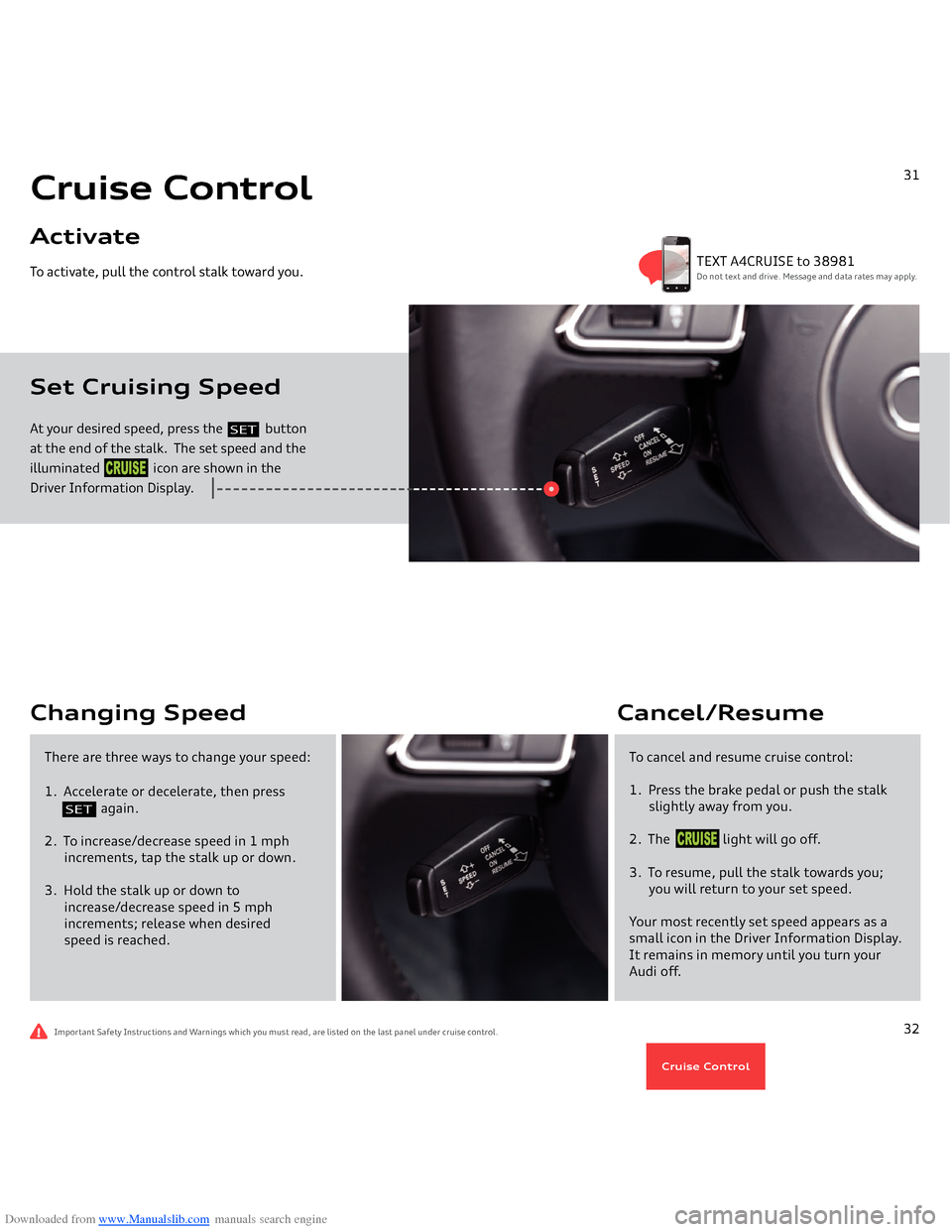
Downloaded from www.Manualslib.com manuals search engine At your desired speed, press the
button
at the end of the stalk. The set speed and the illuminated icon are shown in the Driver Information Display.To activate, pull the control stalk toward you.Set Cruising Speed Cruise ControlActivate
31
SET
CRUISE
TEXT A4CRUISE to 38981Do not text and drive. Message and data rates may apply.
Important Safety Instructions and Warnings which you must read, are listed on the last panel under cruise control.
Changing Speed
To cancel and resume cruise control:1. Press the brake pedal or push the stalk
slightly away from you.2. The light will go off.3. To resume, pull the stalk towards you;
you will return to your set speed.Your most recently set speed appears as a small icon in the Driver Information Display. It remains in memory until you turn your Audi off.Cancel/Resume
There are three ways to change your speed:1. Accelerate or decelerate, then press
again.
2. To increase/decrease speed in 1 mph
increments, tap the stalk up or down.3. Hold the stalk up or down to
increase/decrease speed in 5 mph
increments; release when desired
speed is reached.
32
SET
CRUISECruise Control
Page 20 of 25
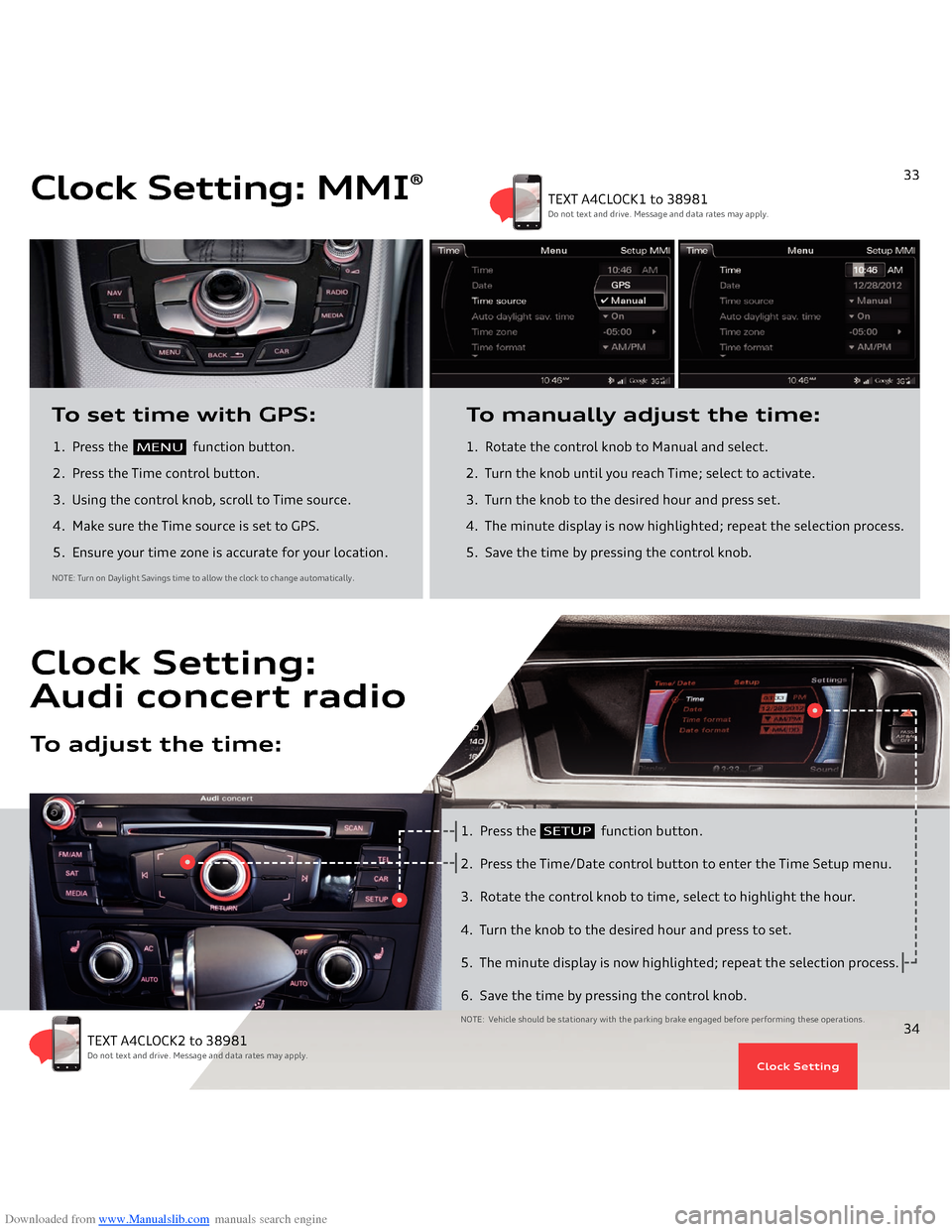
Downloaded from www.Manualslib.com manuals search engine 1. Press the
function button.
2. Press the Time control button.
3. Using the control knob, scroll to Time source. 4. Make sure the Time source is set to GPS.5. Ensure your time zone is accurate for your location.To set time with GPS:
1. Rotate the control knob to Manual and select.
2. Turn the knob until you reach Time; select to activate.3. Turn the knob to the desired hour and press set.4. The minute display is now highlighted; repeat the selection process.5. Save the time by pressing the control knob.To manually adjust the time:
NOTE: Turn on Daylight Savings time to allow the clock to change automatically
.
Clock Setting: MMI
®
MENU
33
TEXT A4CLOCK1 to 38981Do not text and drive. Message and data rates may apply.
1. Press the
function button.
2. Press the Time/Date control button to enter the Time Setup menu.3. Rotate the control knob to time, select to highlight the hour.4. Turn the knob to the desired hour and press to set.5. The minute display is now highlighted; repeat the selection process.6. Save the time by pressing the control knob.NOTE: Vehicle should be stationary with the parking brake engaged before performing these operations.
Clock Setting:Audi concert radioTo adjust the time:
SETUP
34
TEXT A4CLOCK2 to 38981Do not text and drive. Message and data rates may apply.
Clock Setting
Page 21 of 25
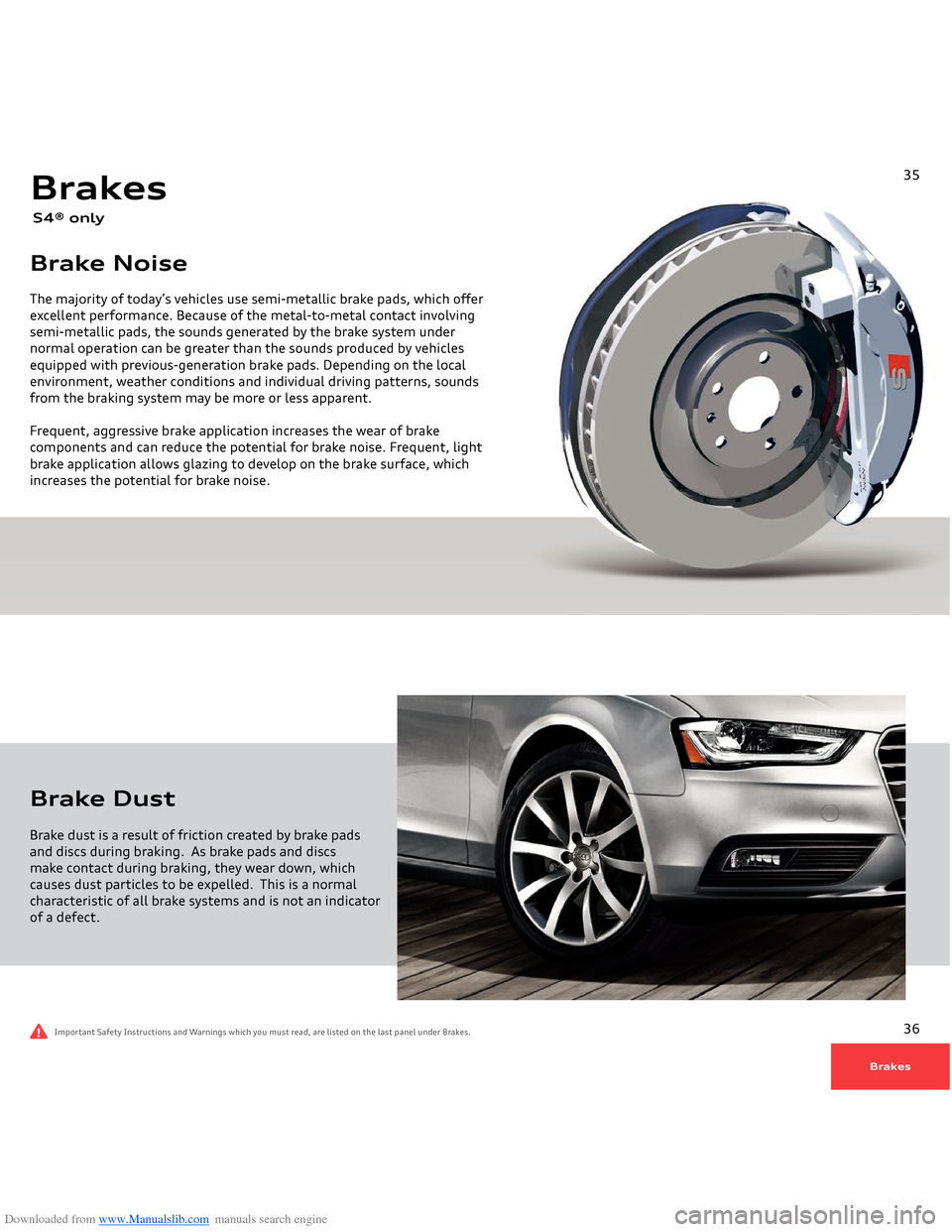
Downloaded from www.Manualslib.com manuals search engine Brake Noise
Brakes S4® onlyThe majority of today’s vehicles use semi-metallic brake pads, which offer excellent performance. Because of the metal-to-metal contact involving semi-metallic pads, the sounds generated by the brake system under normal operation can be greater than the sounds produced by vehicles equipped with previous-generation brake pads. Depending on the local environment, weather conditions and individual driving patterns, sounds from the braking system may be more or less apparent.
Frequent, aggressive brake application increases the wear of brake components and can reduce the potential for brake noise. Frequent, light brake application allows glazing to develop on the brake surface, which increases the potential for brake noise.
35
Brake dust is a result of friction created by brake pads and discs during braking. As brake pads and discs make contact during braking, they wear down, which causes dust particles to be expelled. This is a normal characteristic of all brake systems and is not an indicator of a defect.Brake Dust
Important Safety Instructions and Warnings which you must read, are listed on the last panel under Brakes.
36
Brakes
Page 22 of 25
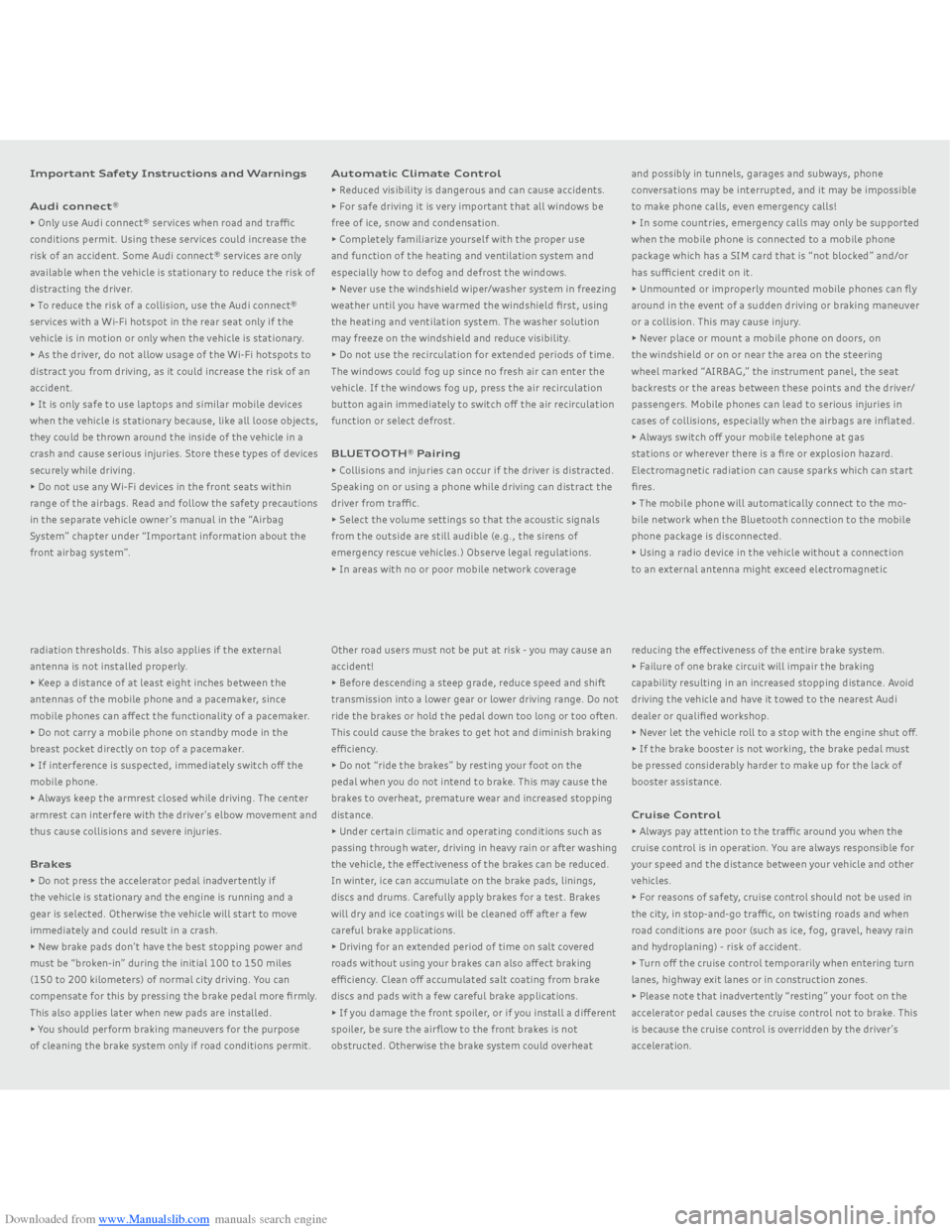
Downloaded from www.Manualslib.com manuals search engine Important Safety Instructions and WarningsAudi connect
®
• Only use Audi connect® services when road and traffic conditions permit. Using these services could increase the risk of an accident. Some Audi connect® services are only available when the vehicle is stationary to reduce the risk of distracting the driver.• To reduce the risk of a collision, use the Audi connect® services with a Wi-Fi hotspot in the rear seat only if the vehicle is in motion or only when the vehicle is stationary.• As the driver, do not allow usage of the Wi-Fi hotspots to distract you from driving, as it could increase the risk of an accident.• It is only safe to use laptops and similar mobile devices when the vehicle is stationary because, like all loose objects, they could be thrown around the inside of the vehicle in a crash and cause serious injuries. Store these types of devices securely while driving.• Do not use any Wi-Fi devices in the front seats within range of the airbags. Read and follow the safety precautions in the separate vehicle owner’s manual in the “Airbag System” chapter under “Important information about the front airbag system”.
Automatic Climate Control• Reduced visibility is dangerous and can cause accidents.• For safe driving it is very important that all windows be free of ice, snow and condensation.• Completely familiarize yourself with the proper use and function of the heating and ventilation system and especially how to defog and defrost the windows.• Never use the windshield wiper/washer system in freezing weather until you have warmed the windshield first, using the heating and ventilation system. The washer solution may freeze on the windshield and reduce visibility.• Do not use the recirculation for extended periods of time. The windows could fog up since no fresh air can enter the vehicle. If the windows fog up, press the air recirculation button again immediately to switch off the air recirculation function or select defrost.BLUETOOTH
® Pairing
• Collisions and injuries can occur if the driver is distracted. Speaking on or using a phone while driving can distract the driver from traffic.• Select the volume settings so that the acoustic signals from the outside are still audible (e.g., the sirens of emergency rescue vehicles.) Observe legal regulations.• In areas with no or poor mobile network coverage
and possibly in tunnels, garages and subways, phone conversations may be interrupted, and it may be impossible to make phone calls, even emergency calls!• In some countries, emergency calls may only be supported when the mobile phone is connected to a mobile phone package which has a SIM card that is “not blocked” and/or has sufficient credit on it.• Unmounted or improperly mounted mobile phones can fly around in the event of a sudden driving or braking maneuver or a collision. This may cause injury.• Never place or mount a mobile phone on doors, on the windshield or on or near the area on the steering wheel marked “AIRBAG,” the instrument panel, the seat backrests or the areas between these points and the driver/passengers. Mobile phones can lead to serious injuries in cases of collisions, especially when the airbags are inflated.• Always switch off your mobile telephone at gas stations or wherever there is a fire or explosion hazard. Electromagnetic radiation can cause sparks which can start fires.• The mobile phone will automatically connect to the mo
-
bile network when the Bluetooth connection to the mobile phone package is disconnected.• Using a radio device in the vehicle without a connection to an external antenna might exceed electromagnetic
radiation thresholds. This also applies if the external antenna is not installed properly.• Keep a distance of at least eight inches between the antennas of the mobile phone and a pacemaker, since mobile phones can affect the functionality of a pacemaker.• Do not carry a mobile phone on standby mode in the breast pocket directly on top of a pacemaker.• If interference is suspected, immediately switch off the mobile phone.• Always keep the armrest closed while driving. The center armrest can interfere with the driver’s elbow movement and thus cause collisions and severe injuries.Brakes• Do not press the accelerator pedal inadvertently if the vehicle is stationary and the engine is running and a gear is selected. Otherwise the vehicle will start to move immediately and could result in a crash.• New brake pads don’t have the best stopping power and must be “broken-in” during the initial 100 to 150 miles (150 to 200 kilometers) of normal city driving. You can compensate for this by pressing the brake pedal more firmly. This also applies later when new pads are installed.• You should perform braking maneuvers for the purpose of cleaning the brake system only if road conditions permit.
Other road users must not be put at risk - you may cause an accident!• Before descending a steep grade, reduce speed and shift transmission into a lower gear or lower driving range. Do not ride the brakes or hold the pedal down too long or too often. This could cause the brakes to get hot and diminish braking efficiency.• Do not “ride the brakes” by resting your foot on the pedal when you do not intend to brake. This may cause the brakes to overheat, premature wear and increased stopping distance.• Under certain climatic and operating conditions such as passing through water, driving in heavy rain or after washing the vehicle, the effectiveness of the brakes can be reduced. In winter, ice can accumulate on the brake pads, linings, discs and drums. Carefully apply brakes for a test. Brakes will dry and ice coatings will be cleaned off after a few careful brake applications.• Driving for an extended period of time on salt covered roads without using your brakes can also affect braking efficiency. Clean off accumulated salt coating from brake discs and pads with a few careful brake applications.• If you damage the front spoiler, or if you install a different spoiler, be sure the airflow to the front brakes is not obstructed. Otherwise the brake system could overheat
reducing the effectiveness of the entire brake system.• Failure of one brake circuit will impair the braking capability resulting in an increased stopping distance. Avoid driving the vehicle and have it towed to the nearest Audi dealer or qualified workshop.• Never let the vehicle roll to a stop with the engine shut off.• If the brake booster is not working, the brake pedal must be pressed considerably harder to make up for the lack of booster assistance. Cruise Control
• Always pay attention to the traffic around you when the cruise control is in operation. You are always responsible for your speed and the distance between your vehicle and other vehicles.• For reasons of safety, cruise control should not be used in the city, in stop-and-go traffic, on twisting roads and when road conditions are poor (such as ice, fog, gravel, heavy rain and hydroplaning) - risk of accident.• Turn off the cruise control temporarily when entering turn lanes, highway exit lanes or in construction zones.• Please note that inadvertently “resting” your foot on the accelerator pedal causes the cruise control not to brake. This is because the cruise control is overridden by the driver’s acceleration.
Page 23 of 25
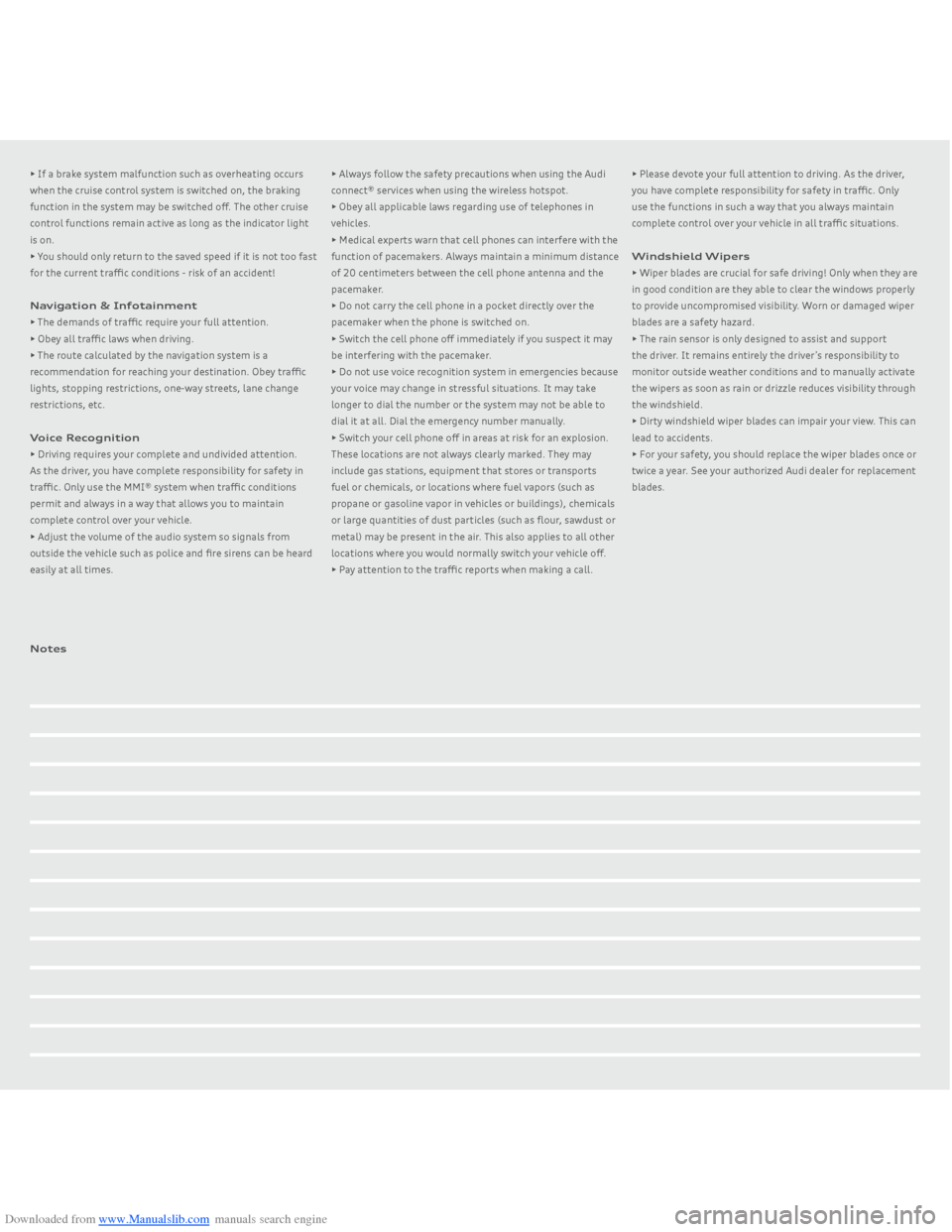
Downloaded from www.Manualslib.com manuals search engine • If a brake system malfunction such as overheating occurs when the cruise control system is switched on, the braking function in the system may be switched off. The other cruise control functions remain active as long as the indicator light is on.• You should only return to the saved speed if it is not too fast for the current traffic conditions - risk of an accident!
Navigation & Infotainment
• The demands of traffic require your full attention.• Obey all traffic laws when driving.• The route calculated by the navigation system is a recommendation for reaching your destination. Obey traffic lights, stopping restrictions, one-way streets, lane change restrictions, etc.Voice Recognition• Driving requires your complete and undivided attention. As the driver, you have complete responsibility for safety in traffic. Only use the MMI® system when traffic conditions permit and always in a way that allows you to maintain complete control over your vehicle.• Adjust the volume of the audio system so signals from outside the vehicle such as police and fire sirens can be heard easily at all times.
• Always follow the safety precautions when using the Audi connect® services when using the wireless hotspot.• Obey all applicable laws regarding use of telephones in vehicles.• Medical experts warn that cell phones can interfere with the function of pacemakers. Always maintain a minimum distance of 20 centimeters between the cell phone antenna and the pacemaker.• Do not carry the cell phone in a pocket directly over the pacemaker when the phone is switched on.• Switch the cell phone off immediately if you suspect it may be interfering with the pacemaker.• Do not use voice recognition system in emergencies because your voice may change in stressful situations. It may take longer to dial the number or the system may not be able to dial it at all. Dial the emergency number manually.• Switch your cell phone off in areas at risk for an explosion. These locations are not always clearly marked. They may include gas stations, equipment that stores or transports fuel or chemicals, or locations where fuel vapors (such as propane or gasoline vapor in vehicles or buildings), chemicals or large quantities of dust particles (such as flour, sawdust or metal) may be present in the air. This also applies to all other locations where you would normally switch your vehicle off.• Pay attention to the traffic reports when making a call.
• Please devote your full attention to driving. As the driver, you have complete responsibility for safety in traffic. Only use the functions in such a way that you always maintain complete control over your vehicle in all traffic situations.Windshield Wipers• Wiper blades are crucial for safe driving! Only when they are in good condition are they able to clear the windows properly to provide uncompromised visibility. Worn or damaged wiper blades are a safety hazard.• The rain sensor is only designed to assist and support the driver. It remains entirely the driver’s responsibility to monitor outside weather conditions and to manually activate the wipers as soon as rain or drizzle reduces visibility through the windshield.• Dirty windshield wiper blades can impair your view. This can lead to accidents.• For your safety, you should replace the wiper blades once or twice a year. See your authorized Audi dealer for replacement blades.
Notes
Page 24 of 25
Downloaded from www.Manualslib.com manuals search engine Notes